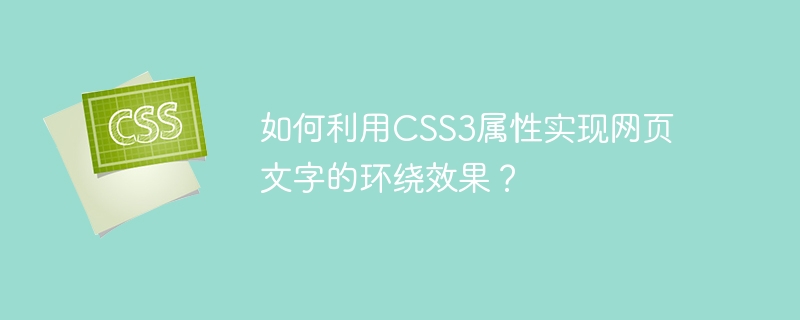

How to use CSS3 properties to achieve the wrapping effect of web page text?
In modern web design, text wrapping effect is a common and interesting display method. By using CSS3 properties, we can easily achieve the wrapping effect of web text. This article will introduce some commonly used CSS3 properties and their application in achieving text wrapping effects.
1. Float attribute
The float attribute is an attribute used in CSS to set the float of an element. Combined with the clear attribute, the effect of text wrapping around the image can be achieved. The following is an example:
<style>
.text {
width: 250px;
float: left;
margin-right: 20px;
}
.image {
width: 250px;
float: right;
margin-left: 20px;
}
.clear {
clear: both;
}
</style>
<div class="text">
<p>这是一段环绕图片的文字</p>
</div>
<div class="image">
<img src="example.jpg" alt="示例图片">
</div>
<div class="clear"></div>In the above example, we place the text and image in two div elements respectively, and set styles such as width, float, and margins. Finally, clear the float with an empty div element to prevent subsequent elements from appearing next to the floated element.
2. The shape-outside attribute
The shape-outside attribute can be used to define the shape of the element to achieve the effect of text wrapping around a non-rectangular shape. The following is an example:
<style>
.shape {
width: 200px;
height: 200px;
shape-outside: circle(50%);
float: left;
margin-right: 20px;
}
</style>
<div class="shape">
</div>
<p>这是一段环绕形状的文字。Lorem ipsum dolor sit amet, consectetur adipiscing elit, sed do eiusmod tempor incididunt ut labore et dolore magna aliqua.</p>In the above example, we define a circular shape through the shape-outside attribute, and achieve the effect of text wrapping around the circle through styles such as floating and margins.
3. Writing-mode attribute
The writing-mode attribute can be used to control the way text is written. Combined with the transform attribute, you can achieve the wrapping effect of text along any path. Here is an example:
<style>
.path {
width: 300px;
height: 300px;
margin: 0 auto;
border: 1px solid #000;
writing-mode: vertical-lr;
transform: rotate(180deg);
}
</style>
<div class="path">
<p>这是一段沿着路径环绕的文字。</p>
</div>In the above example, we set the writing mode of the text to vertical through the writing-mode attribute, and then rotate the element 180 degrees through the transform attribute so that the text wraps along the path.
Through the above example, we can see that using CSS3 properties can easily achieve the wrapping effect of web page text. We can select and combine different attributes according to specific needs to achieve the desired effect. Of course, in addition to the properties introduced above, there are many other CSS3 properties that can be used to implement text wrapping effects, and readers can further explore and try them. Hope this article is helpful to you!
The above is the detailed content of How to use CSS3 properties to achieve the wrapping effect of web page text?. For more information, please follow other related articles on the PHP Chinese website!
 How to make charts and data analysis charts in PPT
How to make charts and data analysis charts in PPT
 Android voice playback function implementation method
Android voice playback function implementation method
 AC contactor use
AC contactor use
 The difference between vscode and visual studio
The difference between vscode and visual studio
 The difference between Java and Java
The difference between Java and Java
 Introduction to hard disk interface types
Introduction to hard disk interface types
 nagios configuration method
nagios configuration method
 How to delete a folder in linux
How to delete a folder in linux




